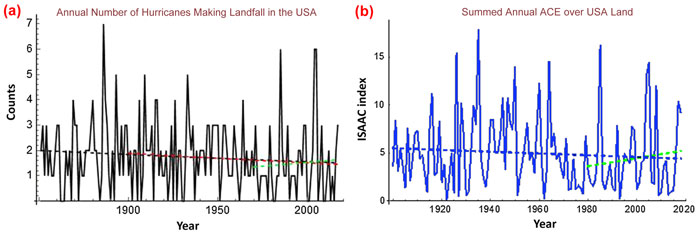| Tweet | Follow @co2science |
Paper Reviewed
Loehle, C. and Staehling, E. 2020. Hurricane trend detection. Natural Hazards https://doi.org/10.1007/s11069-020-04219-x.
In a recent study Loehle and Staehling (2020) say there is a lack of consensus in the scientific literature on whether or not hurricanes are becoming more frequent or more severe as a result of climate change, noting for example that "various studies have found upward, downward, or flat trends in hurricane numbers over various time periods and for different basins." Such lack of consensus, they opine, could well be an artifact of the time period or method of analysis selected, and they thus go on to illustrate this point by examining hurricane trends in the Atlantic Basin over the period 1851-2017. In particular, they focused on records of US continental hurricane landfall counts (frequency) and accumulated cyclone energy (intensity) over the continental USA.
The results of their analysis revealed that hurricane landfall counts in the USA (all hurricane categories, i.e., Category 1-5) experienced a non-significant decline (slope of -0.29 per century) across the entire 167-year period (see Figure 1a). Major hurricanes (Category 3 or greater) also exhibited no detectable trend in counts over the period of study.
Next, Loehle and Staehling repeated their trend analysis using three different starting points in the record, finding that "for all three time periods (starting in 1851, 1900, and 1980) and both all storms and strong storms [the Poisson regressions] are not different from a zero slope, have nonsignificant parameters, and are visually indistinguishable from linear regression trends." In other words, they found no evidence that hurricane counts making landfall in the USA are undergoing any statistically significant change, regardless of the period of time examined.
The two researchers also evaluated the effects of using short time series on hurricane count trend detection. The results from this portion of their study indicated that "short segments [below 30 years of data] are highly likely to give strong positive or negative trends even when the entire data series has no significant trend." And that finding is capable of explaining why some researchers have seemingly found trends in hurricane data over shorter periods of examination, which trends disappear when a longer period of analysis is performed.
Lastly, similar findings were obtained when the authors examined accumulated cyclone energy (ACE) data. According to Loehle and Staehling, "as with the count data, the 119 year [ACE] data have essentially a zero trend."
In summing up their work in the Conclusion section of their paper, the two scientists write "the results of this analysis suggest that tests for trend changes based on short series may suffer from spurious trends," adding that "attempts to unravel causation using annual hurricane counts and climate variables (e.g., SST, ENSO relationships) may likewise risk spurious correlation unless datasets are long. Indeed, detecting climate changes on short-term timescales in many datasets is often misleading and usually wrong, which is why examination of long-term climate datasets is critical in discerning any human-induced influence.

Figure 1. Panel a: Annual count of hurricanes making landfall in the USA and best-fit Poisson regression trends over the period 1851-2017. Black dashed line is the full series trend, red dashed line is the trend since 1900 and the green dashed line is the series trend since 1980. None of the regression lines are significant; all have P values greater than 0.05. Panel b: Annual summed accumulated cyclone energy (ACE) over the continental USA landbase. Blue dashed line is the full series trend and the green dashed line is the series trend since 1980. Once again, none of the regression lines are significant; all have P values greater than 0.05. Adapted from Loehle and Staehling (2020).




